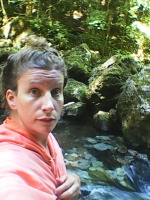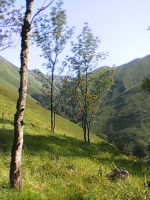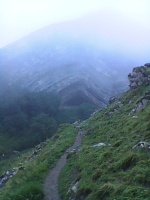After many years with no real vacations, I was reminded of that possibility by the human resource department at the University of Göttingen, and I therefore took a 3-week vacation to go to the Pays Basque (French Basque Country).
I spent the first 10 days in Bayonne, where my grandfather grew up alongside his brother who became a local politician. I kept busy trying to follow attractions in and around Bayonne, and still, there were a lot of things I did not have time to do. The area is very well networked with bus lines and there are bikes to borrow for free from the Tourism Office.

There are many events going on the whole summer, like open air markets, choir singing and sport events. There are also many things to visit, like the Musée Basque in Bayonne, the Izadia Nature Park in Anglet, the beach in Biarritz, and the Arènes in Bayonne, where corridas take place.
I also used that time to prepare the next 10 days, which I spent hiking in the Pyrénées. I used to do this often during my PhD in Toulouse but I gave my previous hiking equipment away. I therefore had to get a lot of equipment anew, including a rucksack, a canteen, a camping stove, a compass, and a duffel bag.
Before leaving for 10 days out in the mountains, I did a little training walk from Bayonne to the Croix de Mouguerre, which commemorates the campaign of Soult against the invading troops of Wellington at the end of Napoléon’s empire in 1813-1814. This was a place my grandfather spoke about. He was a retired general when I knew him, doing archaeological digs into protohistorical defensive enclosures. He also researched the military history of the region, in particular the famous battle of Saint Pierre d’Irube, close to where he lived.
After final adjustments following this training walk, I took the train to Bidarray and started the GR10, which is a hiking path all though the Pyrénées from the Atlantic to the Mediterranean. This was the middle of the day, hard work going up, indeed I stopped every hour for rest. This was very slow, I was definitely not at the top of my form! In the evening, I found a nice place close to a spring, next to the pass of Harrieta, where I slept in a small recess in a cliff.
In the morning, you could not see more than 10 meters ahead due to the fog, but the way was very well marked. I reached Saint-Etienne-de-Baïgorry in the evening, for a day of rest. On that day, I was lucky because a festival of Basque rural sports (Force Basque) was organized, which was very entertaining.

The next day, I made my way towards St Jean Pied de Port, a relatively easy portion of the GR10. I slept under a cross in an open field above the city, which I then reached in the morning. I spent the day visiting the city and resting by the river, before making my way up on the way to the Harpéa, a cave that is also still used for herding.
I stopped on my way to sleep again under the stars on top of a hill, the wind was really strong during the night. I then made my way up to the sources of the Nive, a river that ends up in Bayonne. I spent the afternoon there, meeting a nice and interesting German lady, whom I redirected to some other better trails where to enjoy the surrounding mountains at her level of experience.


I then went way up to the Harpéa, in which I had to take refuge during the night because of rain and thunder. Those were of really quite high intensity the whole night, indeed, people asked me the following days how it was up there that night because they also heard it and felt it down in the valleys. Funnily, a few pigs took refuge there also during the night, waking me up frightened. I hung my hammock to a barrier leading to the grotto in order to avoid sleeping on the floor at their level! I have my standards! :-)


In the morning, again very dense fog, but easy way following the road to the plateau of Azpegi. Early human inhabitants buried their dead in dolmens there (neolithic era), and later left their ashes in cromlechs. Those are still visible there, but really difficult to find when, as on that day, fog is impenetrable.
I reached an unattended refuge at Azpegui, which had a very good spring, which I used to wash much of my equipment. Weather was now sunny which allowed me to also dry it. At the refuge came a Spanish family from Saint James of Compostella, up there with their car, who took their dinner there and generously shared their cheese, bread and chorizo with me.

In the evening, since the refuge had a fireplace, I decided to made a nice fire, but it turned out the fireplace did not draw well at all, and the whole refuge became very smoky! I had to open the door and the windows to get rid of that. The night was disturbed by a car travelling couple, who, despite the refuge being forbidden for car tourists, spent their night there. They certainly were not fit for it, and could not sleep well on the floor, waking me up several times with their noise as they constantly tried to find a comfortable position. I hope they will have learned a lesson from this bad night :-\ As for me, after a few nights outside, sleeping rough on the hard floor was not an issue. ;-)
In the next day, I went back down in France, in the opposite direction to the pilgrims of Saint James, who were going up in droves from Saint Jean Pied de Port, exhausted from what was for many of them the first stage on their walk. I let the bulk of them pass by, watching them go by at the pass of Ronceveaux, before then making my way down.
I made my own pilgrimage 20 years ago, so it was fun for me to make some part of the way in the opposite direction 20 years later. I had not had the opportunity to do so, because I did not use the Camino Frances to go back, I rather used the Camino del Norte along the coast, and then the Camino Aragonés to cross the border to France at the col du Somport.
Finally, after a too long day of walk, I arrived to the nice Gite Azkorria in St Jean Pied de Port, where the breakfast bread was really good. I spent two days there resting a bit, enjoying the city, going to watch pelotaris (players of Basque pelota), and getting some fresh food, fresh news and fresh books.
